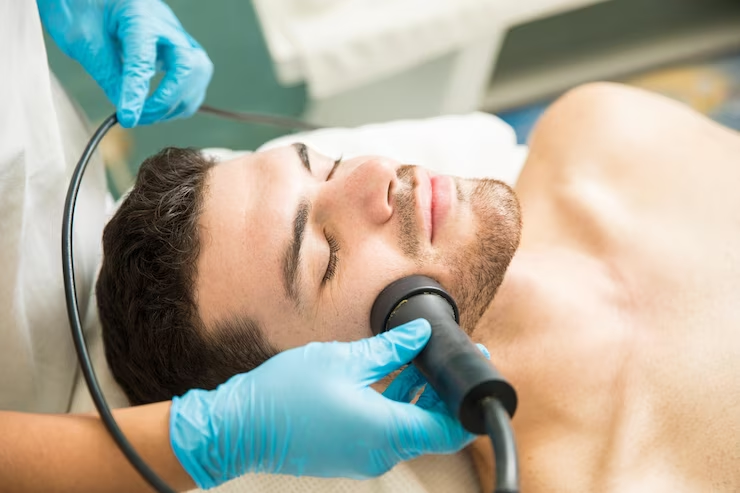
If you've been struggling with acne scars, you know how devastating it can be to look in the mirror and see the aftermath of your skin's worst days. You may have tried every treatment under the sun—from chemical peels to lasers—but your skin still looks blotchy and discolored.
Microneedling for acne scars is a new, minimally invasive procedure that could change everything for you. But what is microneedling? How does it work? And why should you consider it?
In this blog post, we'll answer all these questions so you can feel confident in deciding whether microneedling is right for you.
What is microneedling?
Microneedling is a minimally invasive non-surgical procedure for facial rejuvenation that uses a microneedling device to create a controlled skin injury. It is also known as collagen induction therapy. This treatment uses microneedles to create thousands of microscopic channels in the skin. The channels are then filled with a topical solution to promote healing and regeneration. This process is repeated several times, depending on your individual needs.
Skin microneedling causes minimal damage to skin, unlike chemical peels, LASER treatment and Dermabrasion procedures.
Various microneedling devices include;
Dermapen
Derma Stamps
Radial discs
Dermaroller
These incorporate fine microneedles of various diameter and length, which are constructed with a range of materials like glass, silicon, polymers and metals. Typically needles are around 0.5mm in length which minimizes bleeding and enables rapid recovery.
According to the
American Academy of Dermatology Association (AAD)
, microneedling has been shown to reduce the appearance of scars and dark spots.Microneedling can help treat acne scars by stimulating the production of new collagen in the skin. This helps improve the appearance of scarred tissue and reduce its depth. Microneedling also stimulates new blood vessel growth in the area, which can help reduce redness and inflammation associated with acne-related scarring.
How does Microneedling work?
Controlled skin injury triggers inflammation which results in release of growth factors that produce new collagen, elastin and blood vessels. This improves the skin texture, firmness, elasticity and hydration while reducing scars. It is even suitable for thin and sensitive skin. This procedure is well tolerated and accepted by patients. You can resume your usual activities after a few days.Benefits of Microneedling for Acne Scars
Microneedling is a minimally invasive skin treatment that has been gaining popularity recently.
There are numerous benefits of microneedling, including:
Reduces the appearance of scars
Promote healing and reduce inflammation associated with scarring
Reducing the appearance of hyperpigmentation (such as melasma)or dark spots
Helps shrink pores and minimize their appearance
Helps to improve skin tone, elasticity, and the appearance of stretch marks
It helps plump up fine lines and wrinkles, helping them appear less noticeable
Tightens sagging skin
Encourages hair growth beneficial for people with alopecia
Microneedling is considerably less expensive than laser skin resurfacing, ranging from $600 to $3,000 per treatment.
Microneedling is also much less invasive than laser skin resurfacing, which involves cutting away layers of the skin and then healing them over time. Microneedling involves puncturing the top layer of skin with needles and then letting it heal naturally. Therefore it is relatively safe.
How To Prepare For Microneedling Treatment

Skip the exfoliants
Retinoids can be stopped 48 hours prior to the procedure. Blood thinning agents and anti-inflammatory medications will be stopped 3 to 7 days prior to the procedure. Your dermatologist will advise you appropriately regarding preparation.
Your skin is going to be super sensitive after your microneedling session. This means you should refrain from using abrasive skincare products. Use products that are oil-free, non-comedogenic, and have a pH of 5.5 or lower.
Avoid other beauty treatments
Avoid hair removal and laser treatments for three weeks before your treatment. Microneedling can cause superficial skin damage, so you must avoid any treatments that could make your skin more susceptible to damage.
Keep your skin clean
You should wash your face with warm water and a gentle cleanser in the morning. Then use a toner that dries quickly but not too forcefully—this will help reduce redness. After you've dried your face, apply an oil-free moisturizer that won't clog pores or cause irritation.
What to Expect After Microneedling for Acne Scars
After your microneedling treatment for acne scars, you might notice:
Redness and swelling.
After treatment, your skin will be flushed or bright red—that's normal! It indicates that the collagen and elastin underneath your skin are being stimulated to grow. The redness should fade within 48 hours, but if it lasts several days, don't worry—this is also normal. You can apply a cool compress gently on the affected areas.Dryness or flaking
. Your skin will be dry for a few days after microneedling, so avoid rubbing it too hard when washing. You can use a moisturizer to keep it hydrated during this period. If you're experiencing excessive dryness or flaking that lasts longer than a week after your procedure, contact your dermatologist—they may recommend using prescription-strength moisturizers or other treatments to address the issue.Sensitivity to sun
. Healing takes place under the surface of your skin for up to 2 months after a microneedling session. During this time, your skin will likely be sensitive to sunlight and other irritants—so don't put anything on it except sunblock and moisturizer.Visible results
. You can expect a visible recovery in the first day or two after treatment. But because regenerating collagen takes time, healing under the surface of your skin may take up to two months.Skin infections
can occur with bacteria or herpes simplex virus (cold sores). Sometimes acne flares can occur which are usually mild. Other side effects include bumps, breakouts, and dry skin—these should go away within one week but may persist longer if your skin is extra sensitive to the procedure.Aftercare After Microneedling for Acne Scars

After your microneedling treatment, taking good care of your skin is essential. To get the best results and to ensure that you're not putting yourself at risk for infection or further damage, here are some aftercare tips:
If you plan to be outdoors, apply a broad-spectrum sunscreen rated SPF 30 or higher during the day.
Use topical antibiotic cream immediately after the procedure and twice a day until your next treatment.
Use a suitable emollient to moisturize your skin.
Wash your hands with soap and water before touching any part of your face.
Avoid situations where you might sweat heavily, like the gym or a hot day at the beach.
Avoid using makeup for at least 48 hours.
What Products To Use and Avoid After Microneedling for Acne Scars
After receiving microneedling treatment for acne scars, you will see some immediate results. However, your skin will also be more sensitive to the sun and other environmental elements.
You don't want to use any exfoliant or retinol for at least 48 hours after microneedling. These types of products will make your skin more sensitive and can irritate it further. You should also avoid vitamin C treatments for the same reason.
After your microneedling treatment, you can start using skin care products again. Your skin will be more sensitive than usual, so it's important to use gentle cleansers and moisturizers that will help protect the skin while it heals.
We recommend using products that contain hyaluronic acid and diluted alcohol-free witch hazel. The hyaluronic acid will help replenish lost moisture in your skin, while the witch hazel helps reduce inflammation caused by microneedling.
When to Seek Medical Help for Microneedling
Microneedling can be a safe, effective way of minimizing fine lines, wrinkles, and scars, but it's important to know when to seek medical help for microneedling. In most cases, you should seek medical help if you experience any of the following symptoms:
If you experience any of the following symptoms, call your doctor:
If you experience a fever over 100.4°F (38°C) or feel cold or flu-like symptoms such as nausea or muscle aches.
If you have hives or a rash that doesn't disappear within two days.
If you are having trouble breathing or wheezing after microneedling.
If you notice a yellow or green discharge from your eyes or nose after microneedling.
If the skin around your eyes is red and swollen after microneedling.
If bleeding occurs after microneedling (don't use pressure on the area).
Signs of infection on treated areas
If pain and itching continues more than a week
Frequently Asked Questions
Is microneedling treatment painful?
While microneedling does not cause any pain, discomfort may be associated with it as the needle is applied to your skin. You may feel some pressure as the needle penetrates your skin, but it should not be unbearable or painful.The more times you have the treatment done, the less intense it will feel as your skin grows accustomed to the procedure.
Who is a good candidate for microneedling?
If you have moderate to severe acne scarring, you may be a candidate for microneedling. Microneedling can help reduce the appearance of scars on your skin and promote new collagen growth, making it ideal for treating acne scars, especially deep or pitted ones.Many people who use microneedling say it's one of their favorite anti-aging treatments because it helps with the following:
Fine lines and wrinkles
Pigmentation issues
Uneven skin tone
How many treatments will I need for microneedling?
The number of treatments you need for microneedling depends on your skin condition and the severity of your acne. You may only need one treatment to see results if you are treating mild acne. However, if you have more severe acne, you may need three or four treatments before seeing results.We recommend seeing a board-certified dermatologist for a consultation before starting microneedling. Your doctor can help you determine the right number of treatments for your skin and goals.
Conclusion
Overall, microneedling for acne scars is an excellent option for those who don't want to undergo more invasive procedures like laser therapy or surgery. It's safe, effective, and relatively inexpensive—and even if it doesn't completely clear up all of your acne scars immediately (which can take 3-4 treatments), it will help improve the appearance of your skin over time!
If you're considering microneedling for acne scars, this article has been helpful! It's always best to speak to a dermatologist before undergoing treatment. Still, it can be beneficial to do your research and weigh the risks and benefits of the procedure.






